In this article we will discuss the age old question of how to make deer repellent. Anyone who lives near a natural or wooded area know that deer can wreck havoc on landscape plants, from azaleas to zinnias, deer love to eat them all. While fences may be the most effective way to keep deer away, they are not always practical or desirable. Natural “deer repellent” shrubs, and commercial products are widely available, but there are easy, inexpensive, and effective ways to make deer repellent right at home.
Oen of the most popular and effective homemade deer deterrents is an egg mixture. One upper-peninsula Michigan homeowner whose hosta flowers were being destroyed by voracious deer swears by a simple, inexpensive repellent she mixes up at home.
“I mix one egg, whisked, with one gallon of water, and splash is on the plants,” she says, “I put the egg in an empty gallon milk jug, and then fill that with water, shaking as I go to keep the foam down. I just sprinkle it directly onto the plants that the deer like to eat, and they deer never touch the egg-spatter plants! I have tried a variety of ways, and this one works the best.”
Variations of this homemade solution include the addition of hot peppers, leaving the eggshells in the solution, and adding soap to the solution. Egg solutions can be left in the sun to putrefy before being used to make them stronger. This will make the job of spraying the plants a little less pleasant, but it is the rotten egg smell that keeps the deer away.
Mixtures containing raw eggs should be kept off of plants meant for human consumption, and away from pets that may become sick from eating it. If repellent is sprinkled around vegetables, or on vegetables for human consumption, great care should be taken in washing any food before eating.
A second type of repellent that can easily be made at home is from soap. In general, soap repellents are less effective at repelling deer than egg-based solutions, but may be more desirable to for use around vegetables that will be eaten later. Dish soap can be mixed into a gallon of water and sprinkled directly onto plants, as described with the egg solutions. Deodorant soap can be placed among plants, either directly on the ground or on stakes. Putting a bar into a stocking will give it something to hang by, and make it last longer.
Start with the simple egg and water solution, and then experiment with variations to find out what works best. Solutions should be applied frequently at first, and immediately after it rains. It only takes a moment for a deer to discover freshly rain-washed flowers, so for any spray-on repellent, vigilance is key. Deer are known to be very habitual about where they feed, and they tend to return to the same spots. Because of this, repellent needs to be applied very diligently at first (immediately after rain, for example), but as time goes on, deer will be less likely to show up in a spot that has been consistently sprayed.











